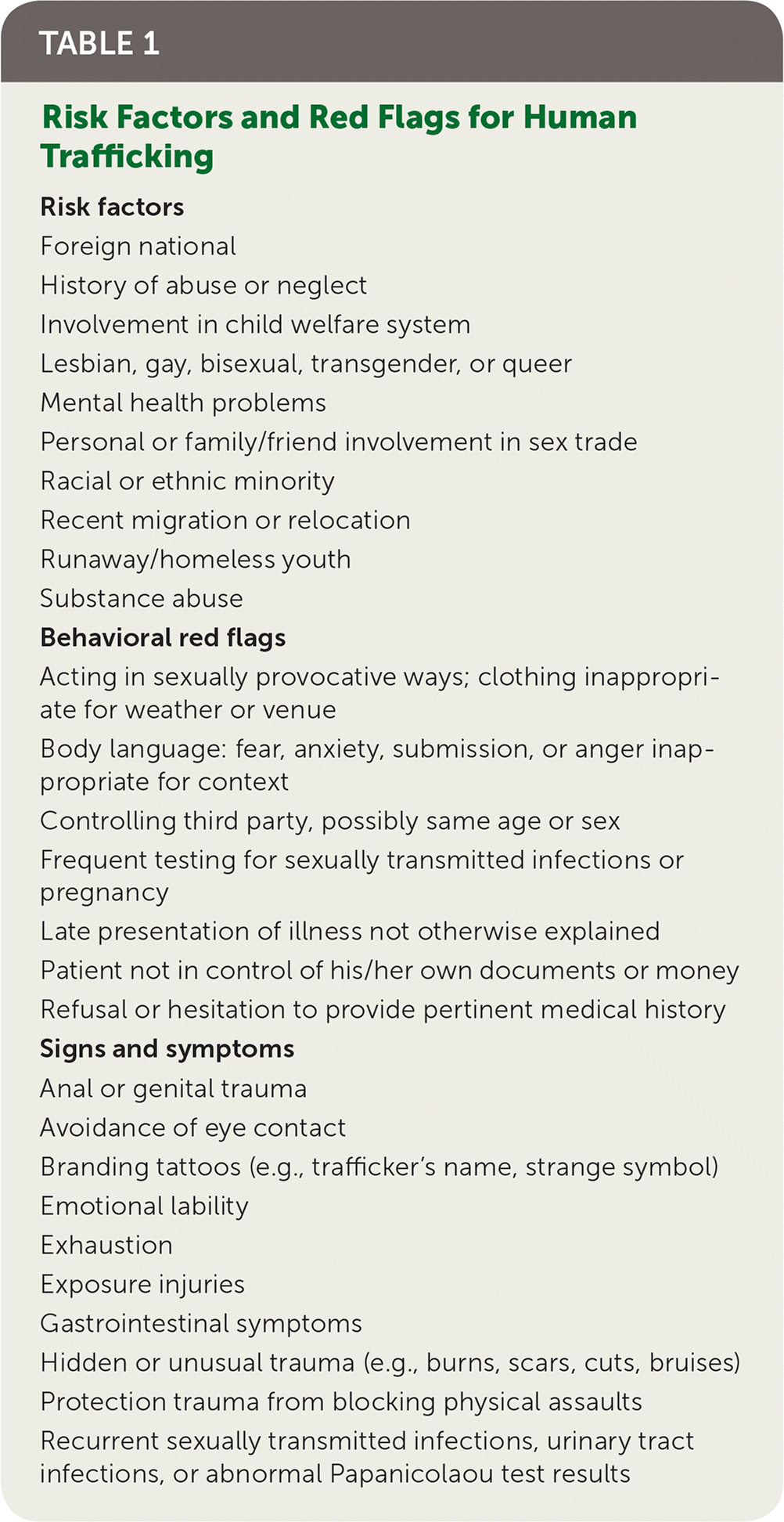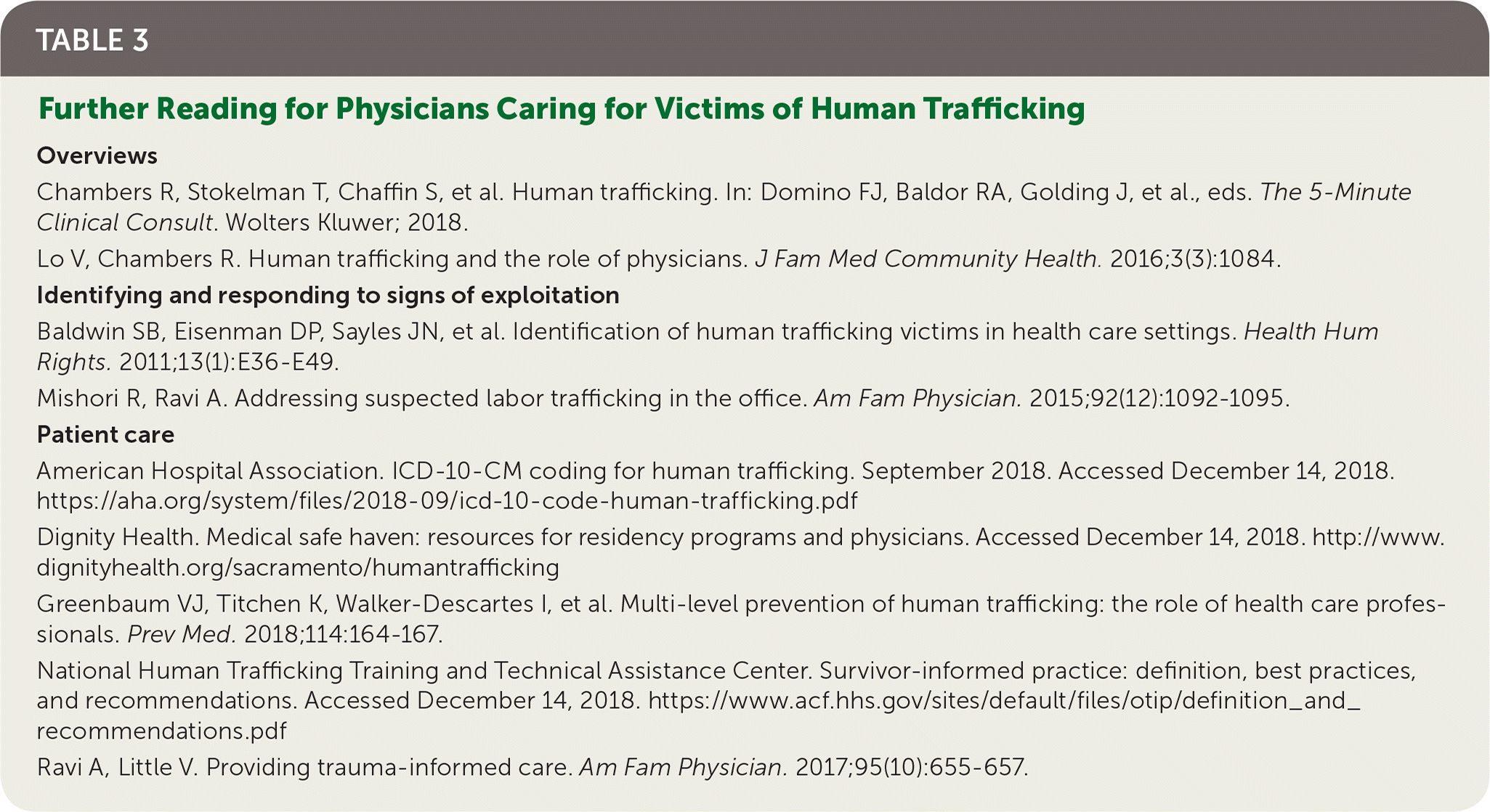
Am Fam Physician. 2019;100(4):202-204
Author disclosure: No relevant financial affiliations.
The Victims of Trafficking and Violence Protection Act of 2000 defined human trafficking as the inducement, recruitment, harboring, transportation, obtaining, or providing of a person by force, fraud, or coercion for commercial sex and/or labor services. Understanding this definition is important clinically to determine if a patient is being trafficked; it distinguishes between willing engagement in an activity (e.g., sex work) and exploitation (e.g., sex trafficking). A practicing physician can consider using the AMP (action, means, purpose) tool1 to assist with this determination. Sex trafficking is the most common type of trafficking reported in the United States, and the most commonly affected groups include adult, female, and minority status individuals.2 Labor trafficking in its various forms is thought to be significantly underreported.
Human trafficking is widespread, and the health care sector is among the few that interact with people while they are being trafficked.3 However, clinicians report that they are poorly prepared, lack the skills and knowledge to engage with human trafficking victims, and do not know how to locate resources for these patients.4 Many physicians misunderstand the issue, fail to recognize its scope, or falsely believe trafficking does not occur in their communities. Human trafficking has been reported in all 50 states and the District of Columbia, and the number of victims and people at risk is in the hundreds of thousands.2,5,6 Physicians who believe they do not care for trafficking victims are wrong: these people come to their practices but are not recognized.
The American Academy of Family Physicians has issued a policy on human trafficking (https://www.aafp.org/about/policies/all/human-trafficking.html). In it, the organization underscores the scope of the problem and discusses family physicians' ability to identify and treat this vulnerable patient population. The policy recognizes the current knowledge gap and makes a formal call for education and training on human trafficking. Despite this growing awareness, family physicians have received little to no education on this subject, and most residency programs provide minimal, if any, training.7
Some are working toward improvement. The largest nonprofit health care organization in California, Dignity Health, has implemented systemwide training for employees and developed protocols and education freely available for adaptation by other hospital systems. The state of New York recently issued a mandate for health care professionals to receive training on human trafficking, and Northwell Health, the state's largest health care provider, has begun to respond. Some federally qualified health centers have launched programs geared toward primary care for patients with histories of exploitation, such as the PurpLE (Purpose: Listen and Engage) Clinic at the Institute for Family Health in New York City. The Dignity Health Methodist Hospital of Sacramento (Calif.) Family Medicine Residency developed a Medical Safe Haven for patients who have experienced trafficking, which includes an educational curriculum for residents and manuals for clinical replication in a private practice or residency clinic. This model is being replicated at Dignity Health residency programs throughout California. Including these programs in primary care residency clinics is one potentially viable method of providing low-cost, widespread care for patients who have experienced trafficking while also training future family physicians to address the issue.
Identifying a trafficking victim requires an understanding of the law as well as knowledge of risk factors and signs and symptoms of exploitation (Table 1). It should be noted that the victim-centered approach built into clinical protocols follows a harm-reduction model, which does not necessarily threaten the trafficker. This is important because many victims have been exploited from a young age and may have significant loyalty to their trafficker despite the trauma inflicted; these people may be in a precontemplative phase of change. Interaction and treatment with a person who has experienced trafficking requires trauma-informed, victim-centered care techniques that are gender and culturally responsive and that use survivor-informed practices. HEAL (health, education, advocacy, linkage) trafficking listservers, SOAR (stop, observe, ask, respond) training, and the National Human Trafficking Hotline (888-373-7888) are reasonable starting points (Table 2 and Table 3).

| Risk factors |
| Foreign national |
| History of abuse or neglect |
| Involvement in child welfare system |
| Lesbian, gay, bisexual, transgender, or queer |
| Mental health problems |
| Personal or family/friend involvement in sex trade |
| Racial or ethnic minority |
| Recent migration or relocation |
| Runaway/homeless youth |
| Substance abuse |
| Behavioral red flags |
| Acting in sexually provocative ways; clothing inappropriate for weather or venue |
| Body language: fear, anxiety, submission, or anger inappropriate for context |
| Controlling third party, possibly same age or sex |
| Frequent testing for sexually transmitted infections or pregnancy |
| Late presentation of illness not otherwise explained |
| Patient not in control of his/her own documents or money |
| Refusal or hesitation to provide pertinent medical history |
| Signs and symptoms |
| Anal or genital trauma |
| Avoidance of eye contact |
| Branding tattoos (e.g., trafficker's name, strange symbol) |
| Emotional lability |
| Exhaustion |
| Exposure injuries |
| Gastrointestinal symptoms |
| Hidden or unusual trauma (e.g., burns, scars, cuts, bruises) |
| Protection trauma from blocking physical assaults |
| Recurrent sexually transmitted infections, urinary tract infections, or abnormal Papanicolaou test results |
| Resource | Website |
|---|---|
| Medical Safe Haven implementation | |
| Dignity Health Human Trafficking Medical Safe Haven | https://www.dignityhealth.org/msh |
| Physician education | |
| National Human Trafficking Hotline | https://humantraffickinghotline.org/ |
| Office on Trafficking in Persons SOAR to Health and Wellness Training | https://www.acf.hhs.gov/otip/training/soar-to-health-and-wellness-training |
| Physicians Against the Trafficking of Humans | https://www.doc-path.org/ |
| Protocols for private practices, residency clinics, and hospital systems | |
| Dignity Health Human Trafficking Response Program Shared Learnings Manual | https://dignityhlth.org/2SZvve1 |
| HEAL Trafficking Protocol Toolkit | https://bit.ly/2MiBo36 |

| Overviews Chambers R, Stokelman T, Chaffin S, et al. Human trafficking. In: Domino FJ, Baldor RA, Golding J, et al., eds. The 5-Minute Clinical Consult. Wolters Kluwer; 2018. Lo V, Chambers R. Human trafficking and the role of physicians. J Fam Med Community Health. 2016;3(3):1084. |
| Identifying and responding to signs of exploitation Baldwin SB, Eisenman DP, Sayles JN, et al. Identification of human trafficking victims in health care settings. Health Hum Rights. 2011;13(1):E36–E49. Mishori R, Ravi A. Addressing suspected labor trafficking in the office. Am Fam Physician. 2015;92(12):1092–1095. |
| Patient care American Hospital Association. ICD-10-CM coding for human trafficking. September 2018. Accessed December 14, 2018. https://aha.org/system/files/2018-09/icd-10-code-human-trafficking.pdf Dignity Health. Medical safe haven: resources for residency programs and physicians. Accessed December 14, 2018. http://www.dignityhealth.org/sacramento/humantrafficking Greenbaum VJ, Titchen K, Walker-Descartes I, et al. Multi-level prevention of human trafficking: the role of health care professionals. Prev Med. 2018;114:164–167. National Human Trafficking Training and Technical Assistance Center. Survivor-informed practice: definition, best practices, and recommendations. Accessed December 14, 2018. https://www.acf.hhs.gov/sites/default/files/otip/definition_and_recommendations.pdf Ravi A, Little V. Providing trauma-informed care. Am Fam Physician. 2017;95(10):655–657. |
